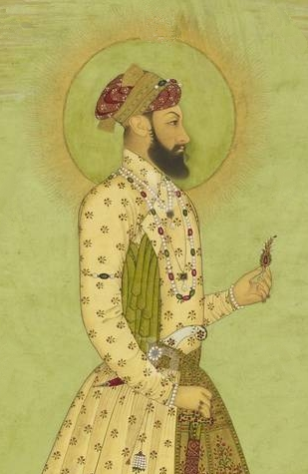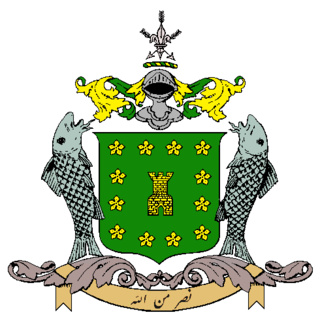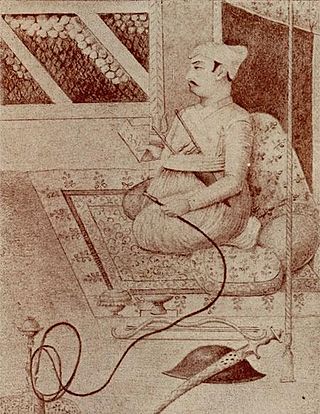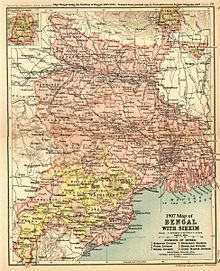
Mirza Azim-ush-Shan was the second son of Mughal emperor Shah Alam I, by his second wife, Amrita Bai, Princess of Kishangarh. He was the great grandson of Emperor Shah Jahan and the grandson of Emperor Aurangzeb, during whose reign he was the last subahdar (viceroy) of Bengal Subah, Bihar Subah and Orissa Subah from 1697 to his death in 1712.

The Nawabs of Bhopal were the Muslim rulers of Bhopal, now part of Madhya Pradesh, India. The nawabs first ruled under the Mughal Empire from 1707 to 1737, under the Maratha Empire from 1737 to 1818, then under British rule from 1818 to 1947, and independently thereafter until it was acceded to the Union of India in 1949. The female nawabs of Bhopal held the title Nawab Begum of Bhopal.

The Nawab of Bengal was the hereditary ruler of Bengal Subah in Mughal India. In the early 18th-century, the Nawab of Bengal was the de facto independent ruler of the three regions of Bengal, Bihar and Orissa which constitute the modern-day sovereign country of Bangladesh and the Indian states of West Bengal, Bihar and Odisha. They are often referred to as the Nawab of Bengal, Bihar and Orissa. The Nawabs were based in Murshidabad which was centrally located within Bengal, Bihar, and Odisha. Their chief, a former prime minister, became the first Nawab. The Nawabs continued to issue coins in the name of the Mughal Emperor, but for all practical purposes, the Nawabs governed as independent monarchs. Bengal continued to contribute the largest share of funds to the imperial treasury in Delhi. The Nawabs, backed by bankers such as the Jagat Seth, became the financial backbone of the Mughal court. During the 18th century, the Nawabs of Bengal were among the wealthiest rulers in the world.

Mir Syed Jafar Ali Khan Bahadur was a commander-in-chief or military general who reigned as the first dependent Nawab of Bengal of the British East India Company. His reign has been considered by many historians as the start of the expansion of British control of the Indian subcontinent in Indian history and a key step in the eventual British domination of vast areas of pre-partition India.

Shahjahan Begum was the Nawab Begum of Bhopal for two periods: 1844–60, and secondly during 1868–1901.

Bhopal State was an Islamic principality founded in the beginning of 18th-century India by the Afghan Mughal noble Dost Muhammad Khan. It was a tributary state during 18th century, a princely salute state with 19-gun salute in a subsidiary alliance with British India from 1818 to 1947, and an independent state from 1947 to 1949. Islamnagar was founded and served as the State's first capital, which was later shifted to the city of Bhopal.

Mir Qasim was the Nawab of Bengal from 1760 to 1763. He was installed as Nawab with the support of the British East India Company, replacing Mir Jafar, his father-in-law, who had himself been supported earlier by the East India Company after his role in winning the Battle of Plassey for the British. However, Mir Jafar eventually ran into disputes with the East India Company and attempted to form an alliance with the Dutch East India Company instead. The British eventually defeated the Dutch at Chinsura and overthrew Mir Jafar, replacing him with Mir Qasim. Qasim later fell out with the British and fought against them at Buxar. His defeat has been suggested as a key reason in the British becoming the dominant power in large parts of North and East India.

Shuja-ud-Din Muhammad Khan was the Nawab of Bengal. He married Zainab un-nisa Begum and Azmat un-nisa Begum, the daughters of Murshid Quli Khan by Nasiri Banu Begum. Shuja-ud-Din's third wife was Durdana Begum Sahiba. After the death of his father-in-law on 30 June 1727, he ascended to the Masnad (throne) of the Nawab.

Bangladesh's military history is intertwined with the history of a larger region, including present-day India, Pakistan, Nepal, Bhutan and Myanmar. The country was historically part of Bengal – a major power in South Asia and Southeast Asia.

Ubaidullah Al Ubaidi Suhrawardy was a Bengali Islamic scholar, educationist and writer from Midnapore. He is often regarded as the Father of modern Islamic education in Bengal.
Begum is a female title which is also used in Mirza families/lineages, Daughter of Beg or Wife of Beg, a given name and surname.

The Bengal Subah, also referred to as Mughal Bengal, was the largest subdivision of Mughal India encompassing much of the Bengal region, which includes modern-day Bangladesh, the Indian state of West Bengal, and some parts of the present-day Indian states of Bihar, Jharkhand and Odisha between the 16th and 18th centuries. The state was established following the dissolution of the Bengal Sultanate, a major trading nation in the world, when the region was absorbed into the Mughal Empire. Bengal was the wealthiest region in the Indian subcontinent.
Mirza Ibrahim Beg, later known as Ibrahim Khan Fath-i-Jang was the Subahdar of Bengal during the reign of emperor Jahangir. He was the brother to Empress Nur Jahan.
Nawab Bahadur was a title of honour bestowed during Mughal Empire and later during British Raj to Indian Muslim individuals for faithful service or acts of public welfare.

The Greater Sylhet region predominantly included the Sylhet Division in Bangladesh, and Karimganj district in Assam, India. The history of the Sylhet region begins with the existence of expanded commercial centres in the area that is now Sylhet City. Historically known as Srihatta and Shilhatta, it was ruled by the Buddhist and Hindu kingdoms of Harikela and Kamarupa before passing to the control of the Sena and Deva dynasties in the early medieval period. After the fall of these two Hindu principalities, the region became home to many more independent petty kingdoms such as Jaintia, Gour, Laur, and later Taraf, Pratapgarh, Jagannathpur, Chandrapur and Ita. After the Conquest of Sylhet in the 14th century, the region was absorbed into Shamsuddin Firoz Shah's independent principality based in Lakhnauti, Western Bengal. It was then successively ruled by the Muslim sultanates of Delhi and the Bengal Sultanate before collapsing into Muslim petty kingdoms, mostly ruled by Afghan chieftains, after the fall of the Karrani dynasty in 1576. Described as Bengal's Wild East, the Mughals struggled in defeating the chieftains of Sylhet. After the defeat of Khwaja Usman, their most formidable opponent, the area finally came under Mughal rule in 1612. Sylhet emerged as the Mughals' most significant imperial outpost in the east and its importance remained as such throughout the seventeenth century. After the Mughals, the British Empire ruled the region for over 180 years until the independence of Pakistan and India. There was a complete list of the different amils who governed Sylhet which was recorded in the office of the Qanungoh of Sylhet. However, most complete copies have been lost or destroyed. Dates from letters and seal traces show evidence that the amils were constantly changed. In 1947, when a referendum was held, Sylhet decided to join the Pakistani province of East Bengal. However, when the Radcliffe Line was drawn up, Karimganj district of Barak Valley was given to India by the commission after being pleaded by Abdul Matlib Mazumdar's delegation. Throughout the History of Sylhet, raids and invasions were also common from neighbouring kingdoms as well as tribes such as the Khasis and Kukis.

Tarakote formerly Shergarh-Tarakote Estate was a quasi princely state in Korei, Odisha which was established under the Mughal Empire as a Sarakaar and was later reduced to an intermediary princely estate during the subsequent Maratha and the British rule. Its capital was at Tarakote, in the western part of the present day Korei block.
Mīrzā Bāqī, also known as Mīrzā Bāqī Beg, was a 17th-century Mughal Empire military general. He served as thanadar in Phuldubi and Bhalwa (Noakhali).

The Greater Jessore region predominantly includes the districts of Jessore, Jhenaidah, Narail and Magura in Bangladesh, as well as the Bangaon subdivision of India. Nestled close to the Sundarbans, the region experienced human settlement early on. It served as the capital city of the Samatata realm and passed through several Buddhist and Hindu kingdoms such as the Palas and Senas. Jessore was ruled by Khan Jahan Ali of Khalifatabad, under the Muslim Sultanate of Bengal, who is credited with establishing the Qasbah of Murali and urbanising the region through advancements in transportation and civilization. Jessore later came to be ruled by various chieftains such as Pratapaditya and became familiar to contemporary European travellers as Chandecan before being annexed to the Mughal Empire in the seventeenth century. By 1757, the British East India Company had dominated and started to establish themselves in the region. British rule lasted up until 1947, with Jessore coming under the Provisional Government of Bangladesh from 1971 onwards.

Nawabzadi Umdatunnissa Begum was the queen consort of Nawab Syed Ahmed Hassan of Kharui Raj. She served as the regent of Kharui for 20 long years i.e. from 1892 to 1912. Nawab Begum gave up purdaah and went to the Court of Wards, Calcutta to fight against the arbitrary economic policies introduced by the British, because of which her estate had suffered severe losses. She challenged the British government in their own court and won the legal battle against them, making her one of the first woman royalties in British Bengal to do so.
















